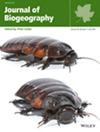肝草植物区系遗传贝塔多样性的全球模式和决定因素
IF 3.4
2区 环境科学与生态学
Q2 ECOLOGY
引用次数: 0
摘要
目的 通过研究系统发育β多样性及其更替和嵌套成分,可以揭示生物群落之间构成相似性(或差异性)的进化原因。肝草是全球大多数陆地生态系统的重要组成部分,但有关肝草系统发育β多样性的研究却很少。在此,我们探讨了全球肝草系统发育β多样性及其两个组成部分的地理模式,并通过系统发育β多样性或系统发育更替与地理和气候距离的关系,评估了扩散限制和环境过滤过程在不同空间范围内形成β多样性模式的相对重要性。方法我们进行了相关和回归分析,将系统发育β多样性及其两个组成部分(周转率和嵌套度)与代表当前气候条件的六个变量和代表历史(第四纪)气候变化的两个变量以及不同空间范围(全球、大陆和区域)的地理和气候距离联系起来。结果我们发现,在考虑的八个当前和历史气候变量中,降水季节性是决定肝草系统发育β多样性的最强因素。在全球范围内,地理距离和气候距离对系统发生更替变异的解释程度相近;而在七大洲中的五大洲,气候距离对系统发生更替变异的解释程度大于地理距离;在区域范围内(直径约为 4000 千米的圆圈),地理距离对系统发生更替变异的影响通常大于气候距离。主要结论我们得出的结论是,扩散限制和环境过滤在形成肝草植物系统发育结构方面都发挥了重要作用,但它们的相对重要性在不同空间尺度和不同地理区域有所不同。本文章由计算机程序翻译,如有差异,请以英文原文为准。
Global patterns and determinants of phylogenetic beta diversity among liverwort floras
AimInvestigating phylogenetic beta diversity, and its turnover and nestedness components, can shed light on the evolutionary causes shaping the similarity (or dissimilarity) in composition between biological assemblages. Liverworts are important constituents of most terrestrial ecosystems worldwide but studies on phylogenetic beta diversity in liverworts are scarce. Here, we explore geographic patterns of phylogenetic beta diversity and its two components in liverworts across the world and evaluate the relative importance of dispersal limitation and environmental filtering processes in shaping beta diversity patterns at different spatial extents by relating phylogenetic beta diversity or phylogenetic turnover to geographic and climatic distances.LocationGlobal.TaxonLiverworts.MethodsWe conducted correlation and regression analyses to relate phylogenetic beta diversity and its two components (turnover and nestedness) to six variables representing current climate conditions and two variables representing historical (Quaternary) climate change, and to geographic and climatic distances at different spatial extents (global, continental, and regional).ResultsWe found that of the eight variables of current and historical climates considered, precipitation seasonality was the strongest determinant of phylogenetic beta diversity in liverworts. At the global extent, geographic and climatic distances explained similar amounts of the variation in phylogenetic turnover, whereas at the continental extent, climatic distance explained more variation than geographic distance in five of the seven continents, and at a regional extent (roughly a circle of 4000 km in diameter), geographic distances generally had a greater effect than climatic distance on phylogenetic turnover.Main ConclusionsWe conclude that both dispersal limitation and environmental filtering played an important role in shaping phylogenetic structure of liverwort floras, but their relative importance varies at different spatial scales and among geographic regions.
求助全文
通过发布文献求助,成功后即可免费获取论文全文。
去求助
来源期刊

Journal of Biogeography
环境科学-生态学
CiteScore
7.70
自引率
5.10%
发文量
203
审稿时长
2.2 months
期刊介绍:
Papers dealing with all aspects of spatial, ecological and historical biogeography are considered for publication in Journal of Biogeography. The mission of the journal is to contribute to the growth and societal relevance of the discipline of biogeography through its role in the dissemination of biogeographical research.
 求助内容:
求助内容: 应助结果提醒方式:
应助结果提醒方式:


